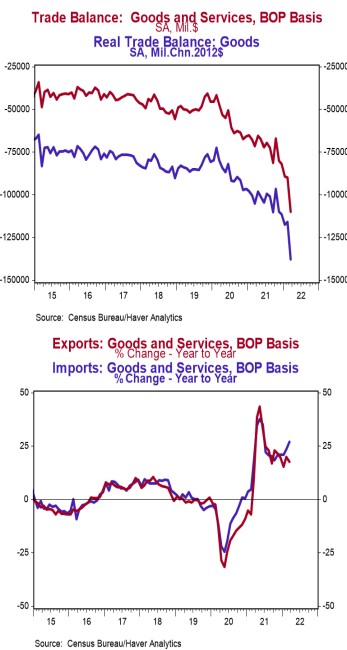- Exports rose by $12.9 billion, led by an increase in other petroleum products, crude oil, fuel oil, and natural gas liquids. Imports rose $32.9 billion, led by finished metal shapes, passenger cars, and other textile apparel & household goods.
- In the last year, exports are up 17.7% while imports are up 27.0%.
- Compared to a year ago, the monthly trade deficit is $38.4 billion larger; after adjusting for inflation, the "real" trade deficit in goods is $32.7 billion larger than a year ago. The "real" change is the trade indicator most important for measuring real GDP.
Implications:
The trade deficit in goods and services came in at $109.8 billion in March, a record high. Imports climbed much faster than exports, signaling a deeper recovery from COVID here than abroad. Many will look at the increase in the trade deficit as a negative, but what really matters is that both exports and imports boomed in March. We like to follow the total volume of trade (imports plus exports), which signals how much businesses and consumers interact across the US border. That measure rose by a record $45.8 billion in March, is up 23.1% versus a year ago, and sits at record highs. Unfortunately, these massive numbers are driven not only by more demand for goods and services, but also higher prices for these goods and services as inflation has soared. Expect the trade deficit to remain volatile from month to month but generally stay large in the months ahead as the US has recovered from the coronavirus faster than most other countries. In addition, Russia's invasion of Ukraine, and shutdowns in China may affect trade patterns for some time. Given massive and artificial government stimulus in the US, both fiscal and monetary, the demand for imports should continue to outstrip the demand for exports to the rest of the world. Also, the US is still running low on inventories for many goods due to the surge in consumer spending. That means the appetite for imports will remain much stronger than normal as companies restock their shelves and warehouses. Supply-chain problems are still a big issue as ports remain overwhelmed in the US, and with the tragic war in Ukraine it is only adding to the problem. For example, the ports of Los Angeles and Long Beach currently have 34 container ships waiting to be unloaded. Although this is close to a recovery low, its well above the 0 - 1 normal level experienced pre-COVID. Also in today's report, after eight months in a row of the dollar value of US petroleum imports exceeding US petroleum exports, the trend reversed in March. It's too early to tell but this is an encouraging sign that the US is getting back to where it was in 2020 when it was a net petroleum exporter. In news today, the ADP employment report showed 247,000 private-sector jobs gained in April. Also yesterday, cars and light trucks were sold at a 14.3 million annual rate in April. The key impediment to auto sales remains supply constraints, largely related to a lack of computer chips. Look for that problem to ease further in the second half of 2022, resulting in a faster pace of sales.





